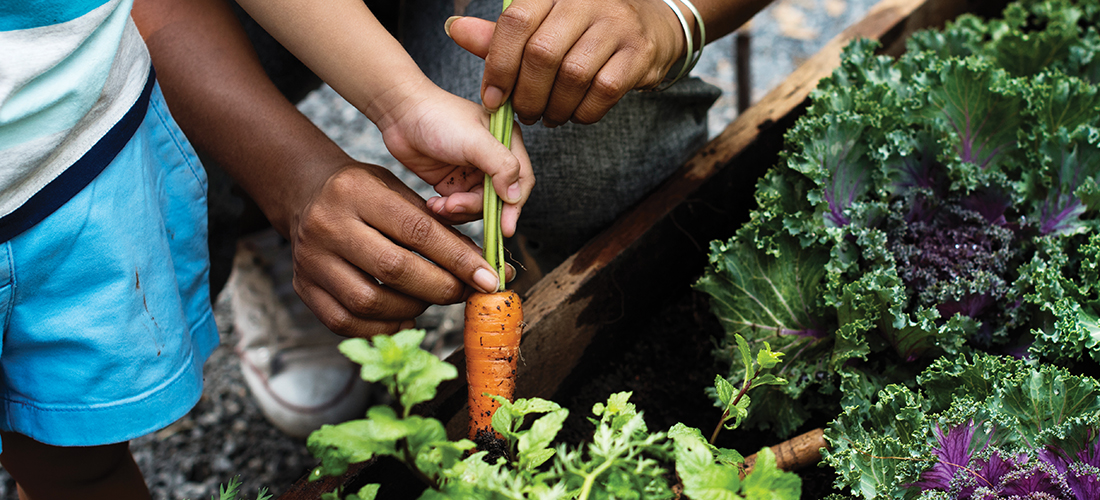
More than just a cute idea
By Jan Leitschuh
The Power of the Garden — it can teach food literacy, bring people together, and teach respect for food as well as the challenges of growing it. In the garden, place-based learning makes it real, relevant and oh-so-remarkable. — from “Musings from a Garden Educator: Sowing the Seeds of Wonder!” by Kathy Byron
April showers might bring May flowers, but local veggie gardens thrive, too. From parsley to asparagus to sugar snap peas, Swiss chard to radishes, strawberries to baby salad greens and green onions, a veritable cornucopia of nutritious produce is coming to fruition.
In schoolyards scattered across Moore County, a different sort of kitchen garden is prospering right now. Picture a successful produce gardener — does the image of a child come to mind? Yet the gardeners are children. Come spring — and, a bit later, autumn — one of the most productive crops might actually be the cultivation of young minds.
“The kids are the ones who plant the gardens,” says Kathy Byron, a former pediatric nurse, longtime Moore County Master Gardener Volunteer and director of the innovative Good Food Sandhills program, an entity of Sandhills Community College (and formerly, the FirstSchool Garden Program). “We use those things they grow for food activities and nutrition education, inside the classroom and out, in school and after school. And then we operate in the community.”
Over more than a decade, deploying the principles of The Edible Schoolyard model, “we outfitted over 61 percent of Moore County schools with school gardens, so over 4,000 kids have access to a school garden,” says Byron. “Currently, we have intensified these efforts in two of our schools that have the highest percentage of students who qualify for free and reduced lunch programs. We have honed our current efforts down to the most high-need youth. “
School gardens tap an innovative principle. “An environment-based education movement — at all levels of education — will help students realize that school isn’t supposed to be a polite form of incarceration, but a portal to the wider world,” writes Richard Louv, author of the best-selling book Last Child in the Woods: Saving Our Children from Nature-Deficit Disorder. Byron would add “and wiser nutritional choices” to the wider world idea.
Louv, Byron and others are at the forefront of an awareness that children need a connection to nature. This awareness has historical echoes. “Man’s heart, away from nature, becomes hard; [the Lakota] knew that lack of respect for growing, living things soon led to lack of respect for humans too,” said the Oglala chief and Native American author Luther Standing Bear, who lived from 1868 to 1939.
Leaving the confines of a school classroom and the climate-controlled halls, elementary students file out into the garden feeling the sunshine on their face and the breeze in their hair. The smell of sweet lavender fills the air, with the ever-constant din of traffic on 15/501 as the background noise for this outdoor classroom. Students’ happy banter, combined with a skip in their step, just confirms their excitement to be in this living laboratory! — “Musings from a Garden Educator”
These gardens generally take the shape of a raised bed or three. Filled with nutrient-rich soil and compost, they can be planted with seasonal vegetables. Planting “season” can happen all year, with collards, kale, spinach (under covers) and parsley in the winter. Cool season veggies such as radish, green onions, peas and salad greens can be added at the appropriate time, followed by a special warm-season planting. That produce is harvested for food-insecure families. In the fall, the cycle begins again, with cool-season veggies.
“Often, we plant butternut squash in summer to harvest in the fall and use through the winter. We use a lot of butternut squash,” says Byron with a laugh.
Fig trees, blueberries and muscadine grapes are also planted in the surrounding garden area. Besides seasonal vegetables and perennial fruits, every garden is planted with perennial herbs and a pollinator garden.
Pollinators and other beneficial insects become our friends and collaborators in making the garden healthy, full of life and amazement. Respecting spiders, ladybugs and assassin bugs as warriors in this ecosystem are some of their first lessons about respect of living things in the garden. Starting from the ground up — soil becomes the medium for planting seeds and seedlings, searching for microbes and inspecting under the microscope to see the world beyond the naked eye. Adding soil amendments such as blood meal and bone meal expands their understanding of nutrients plants provide us through the food we eat. — “Musings from a Garden Educator”
Math and science lessons have been held in the school gardens on nice days. Science and language activities hold interest while practical lessons slide in on the breezes of enthusiasm. “When truly present in nature, we do use all our senses at the same time, which is the optimum state of learning,” writes Louv.
They dig deeper into science and math through hands-on learning activities that allow them to use garden trowels, stinky fish fertilizer, Chromebooks for research. They cuddle chickens and extract DNA from a strawberry. Fractions are fascinating when making garden recipes like veggie tortillas, kale pesto or solar cooked pizza. We congregate around the picnic table to discuss the day’s activities, break into small groups and gather tools for our STEM (Science, Technology, Engineering and Math) Lessons. They fan out throughout the garden with a purpose to complete tasks that enrich their learning in real time. The garden is the premier STEM tool — as old and diverse as humankind and Mother Earth. — “Musings from a Garden Educator”
Movement is an essential component of learning, argue many experts. “A generation of children is not only being raised indoors, but is being confined to even smaller spaces,” writes Louv. “Jane Clark, a University of Maryland professor of kinesiology . . . calls them ‘containerized kids’ — they spend more and more time in car seats, highchairs, and even baby seats for watching TV. When small children go outside, they’re often placed in containers — strollers — and pushed by walking or jogging parents . . . Most kid-containerizing is done for safety concerns, but the long-term health of these children is compromised.”
Children’s health is a big driver for Bryon. School gardens are more than a cute idea, she argues. The stats are sobering. In 2007, North Carolina ranked fifth in the nation for childhood obesity; 42 percent of Moore County students were overweight or obese. Facts such as these moved the pediatric nurse in Byron to action. She observed that Moore County is populated by many low-income communities struggling to access healthy food.
Over a decade later, Byron’s food concerns remain: “Things move slowly. One in four children in N.C. is food-insecure. And despite being an agricultural state, we are eighth in the nation for food insecurity. We work deeply in schools with free and reduced lunch programs, in low-income, high-needs schools. One of our principals noted, we bring experiences to children they would get nowhere else.”
Her work extends to developing local food systems addressing food justice in under-served communities. Through Sandhills Community College Continuing Education, Good Food Sandhills provides a holistic approach to linking the environment, healthy food and people from seed to table, classroom to community.
Respect for life, environment and one’s community evolves naturally as children explore and assimilate the implications of the web of life.
“Passion is lifted from the Earth itself by the muddy hands of the young; it travels along grass-stained sleeves to the heart. If we are going to save . . . the environment, we must also save an endangered indicator species: the child in nature,” says Louv. “We have such a brief opportunity to pass on to our children our love for this Earth, and to tell our stories. These are the moments when the world is made whole.”
“Planting, tending, harvesting and tasting what is grown in the garden changes a child’s relationship with food. It broadens their palate, ties it to their heritage and makes them a partner in the growing process. It is their broccoli, their kale, their radish…and they love it! As Cicero (106 B.C. — 43 B.C.), Roman philosopher, politician, lawyer and orator so eloquently put it . . . If you have a garden and a library, you have everything you need.” — “Musings from a Garden Educator”
For more information on school gardens, or to volunteer, contact Kathy Byron at kbyron@nc.rr.com. PS
Jan Leitschuh is a local gardener, avid eater of fresh produce and co-founder of the Sandhills Farm to Table Cooperative.





